Athens, the capital of Greece, is a city that effortlessly combines the echoes of its ancient heritage with the buzz of modern life. Known as the cradle of Western Civilization and the birthplace of democracy, this historic city offers visitors a unique blend of archaeology, culture, gastronomy, and vibrant street life. Whether you’re a history enthusiast, an art lover, a foodie, or an urban explorer, Athens caters to every type of traveler. With its magnificent ancient ruins, world-class museums, charming neighborhoods, and lively marketplaces, Athens provides a gateway to understanding the rich tapestry of Greek history and culture.
Situated in the heart of Attica, Athens is surrounded by majestic mountains and the Aegean Sea, offering wonderful hiking spots and incredible panoramic views. The city’s streets are lined with cafes, boutiques, and restaurants serving mouthwatering Mediterranean cuisine. At the same time, history lurks around every corner, with iconic landmarks like the Acropolis and the Temple of Olympian Zeus standing as enduring reminders of Athenian glory. In this guide, we’ll delve into the 21 best things to do in Athens, Greece, to help you make the most of your visit to this captivating destination.
Top Attractions in Athens
1. The Acropolis and the Parthenon
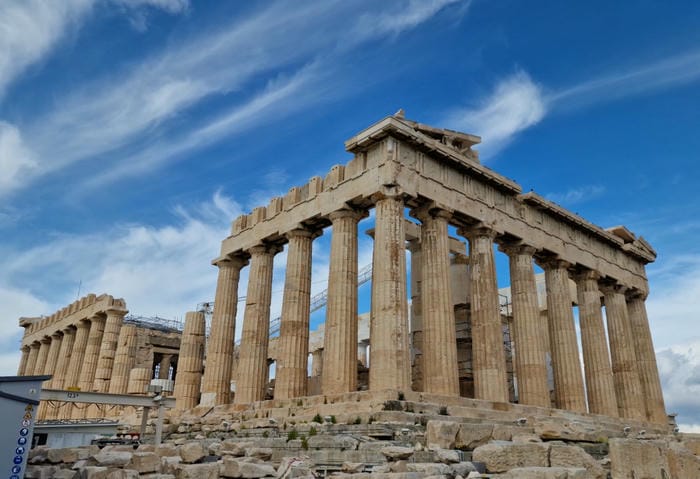
No trip to Athens is complete without visiting the Acropolis, the most iconic symbol of Ancient Greece. Perched on a rocky hill overlooking the city, this UNESCO World Heritage Site is a testament to Athens during its Golden Age. At the heart of the Acropolis stands the Parthenon, a temple dedicated to Athena, the city’s patron goddess. Constructed in 447 BC, the Parthenon is a masterpiece of classical architecture, featuring Doric columns and intricate friezes that tell tales of Greek mythology.
The Acropolis also houses other significant ruins, including the Erechtheion, known for its stunning Caryatid Porch, and the Propylaea, the grand gateway to the ancient citadel. The Temple of Athena Nike, a smaller temple on the site, showcases Athens’ devotion to its protector goddess.
- Tips for Visiting: Arrive early to avoid the crowds and visit during spring or fall to escape the summer heat. Tickets for the Acropolis can also be combined with other archaeological sites for better value. Comfortable shoes are essential, as the area can be slippery and uneven.
Remember to stop at the Acropolis viewpoint to enjoy breathtaking views of modern Athens sprawled beneath you. Visiting the Acropolis is not just sightseeing—it is stepping into one of the most significant chapters of human history.
2. Acropolis Museum
To truly appreciate the Acropolis and its treasures, your next stop should be the Acropolis Museum, situated a stone’s throw from the ancient site. This contemporary museum, with its sleek design and glass-paneled floors, is a treasure trove of artifacts excavated from the Acropolis and its surrounding areas. The museum provides invaluable insight into the rich history of Ancient Greece, connecting the ruins of the Acropolis with the artifacts that once adorned it.
Highlights of the museum include the original Caryatids (statues replaced by replicas at the site) and the Parthenon Frieze, meticulously displayed for visitors to admire. The top floor replicates the dimensions of the Parthenon, offering an immersive experience alongside direct views of the ancient structure itself.
- Tips for Visiting: Allocate at least two hours to explore the museum thoroughly. The café on the museum’s balcony provides a fantastic vantage point of the Acropolis while allowing you to enjoy a coffee or snack.
3. Ancient Agora & Temple of Hephaestus
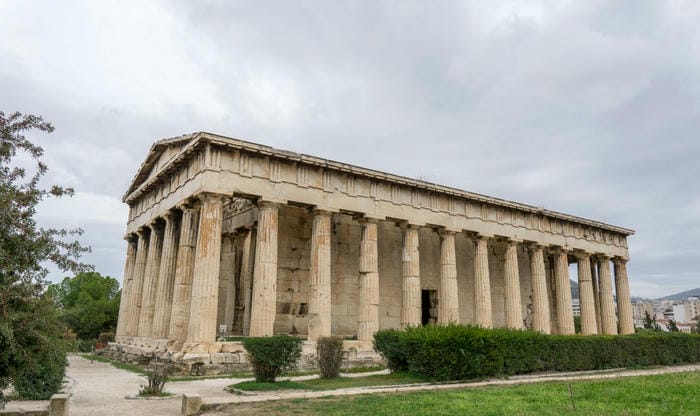
The Ancient Agora once served as the heart of Athenian public life. This sprawling site was a hub for politics, philosophy, commerce, and social gatherings during Ancient Greece’s democratic heyday. Walking through the Agora allows you to envision the vibrant atmosphere that once filled this space.
Among the site’s notable structures is the Temple of Hephaestus, one of the best-preserved ancient Greek temples, dedicated to the god of craftsmanship and fire. Its stunning Doric columns and detailed friezes offer hints of its splendor in antiquity.
Other points of interest include the Attalos Stoa, a reconstructed portico that now houses a small museum, and the Altar of the Twelve Gods, a central religious site during ancient times. For those intrigued by philosophy, the Agora is also linked to Socrates, who spent much of his time engaging in debates here.
- Tips for Visiting: Try to visit during the morning or late afternoon for a cooler, more enjoyable experience. Combination tickets are available with the Acropolis.
4. Roman Agora
The Roman Agora is a fascinating testament to Athens’ transition under Roman rule. Constructed in the 1st century BC with funds from Julius Caesar and Emperor Augustus, this forum replaced the Ancient Agora as the city’s commercial hub.
The centerpiece of the Roman Agora is the Tower of the Winds, an ingenious octagonal structure that served as a water clock, weather vane, and sundial. Nearby are the remains of the Gate of Athena Archegetis, once the main entrance to the marketplace.
Walking among the ruins of the Roman Agora gives visitors a glimpse into life in Roman-occupied Athens, with its changing architecture and urban layout. Though smaller than the Ancient Agora, this site is rich in historical significance and is an easy add-on to your exploration of central Athens.
5. National Archaeological Museum
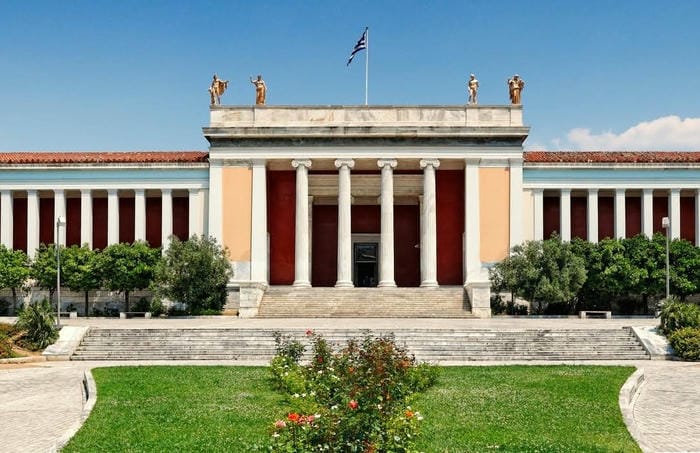
For history and archaeology enthusiasts, a visit to the National Archaeological Museum is a must. As one of the most celebrated museums in the world, it houses Greece’s most extensive and extraordinary collections of artifacts spanning from prehistoric times to late antiquity.
Among its impressive collections, the Mask of Agamemnon—a gold funeral mask dating back to Mycenaean civilization—is a standout. Equally captivating are the Antikythera Mechanism, often regarded as the world’s first analog computer, and the remarkable collection of Greek sculptures and pottery.
With more than 11,000 exhibits, the National Archaeological Museum allows visitors to trace the trajectory of Greek history and art over several millennia.
- Tips for Visiting: Allocate at least 2-3 hours, if not more, to fully explore the museum. Guided tours can provide deeper context for the exhibits, turning your visit into an enlightening educational experience.
6. Plaka Neighborhood
Known as the “Neighborhood of the Gods”, Plaka is one of Athens’ oldest and most picturesque districts, nestled under the slopes of the Acropolis. Its narrow, cobbled streets, pastel-colored houses, and vibrant bougainvillea create an atmosphere that’s both charming and enchanting.
Plaka is a terrific place to wander around, offering a mix of history, shopping, and culinary experiences. Highlights of the area include ancient ruins interspersed with modern-day cafes, artisan boutiques selling handmade goods, and quaint tavernas serving authentic Greek dishes. For museum lovers, the Jewish Museum of Greece and the Museum of Greek Folk Art are small but worthwhile stops in Plaka.
As you explore this lively neighborhood, make sure to visit Anafiotika, a tiny cluster of Cycladic-style houses perched on the northeastern slopes of the Acropolis. This hidden gem feels like a slice of the Greek islands in the heart of Athens.
- Tips for Visiting: Bring comfortable walking shoes, as the streets are often uneven. Evenings are particularly magical when the Acropolis is illuminated, adding to Plaka’s romantic ambiance.
7. Monastiraki Square & Flea Market

Monastiraki Square is one of Athens’ most vibrant and eclectic spots, where history and modernity collide in the best possible way. Surrounded by landmarks such as the Ottoman-era Tzistarakis Mosque, the 18th-century Monastiraki Church, and remnants of Hadrian’s Library, the square offers an unparalleled blend of cultural and architectural diversity.
A short stroll from the square, you’ll find the Monastiraki Flea Market, a lively hub for shopping enthusiasts. Here, you can browse stalls and stores for everything from antiques, souvenirs, and handmade jewelry to vintage clothing and unique trinkets. Bargaining is part of the fun, so don’t hesitate to negotiate for the best price.
The square also has plenty of cafes and tavernas where you can relax and soak up the lively atmosphere. Don’t miss people-watching here—it’s a fascinating way to observe the mix of locals and tourists enjoying themselves.
- Tips for Visiting: Sundays are particularly bustling in the flea market, making it the best day for treasure hunting. Be sure to explore the smaller alleys branching off the main street for hidden gems.
8. Mount Lycabettus
For those seeking the most stunning panoramic views of Athens, a visit to Mount Lycabettus is a must. As the city’s highest point, this limestone hill offers unmatched vistas of the Acropolis, the city, and even the Aegean Sea on clear days. Watching the sunset from Lycabettus is an unforgettable experience, as the golden hues bathe the sprawling metropolis below.
You can hike to the summit via well-marked paths if you’re feeling adventurous. For a more relaxed option, the Lycabettus funicular railway will take you to the top effortlessly. At the summit, you’ll find the charming Chapel of Saint George and a café where you can enjoy a coffee or a light meal while admiring the views.
- Tips for Visiting: Early morning or late afternoon is ideal for visiting to avoid the midday heat. Wear sturdy footwear if you opt for the hike, as some paths can be steep or uneven.
9. Philopappou Hill
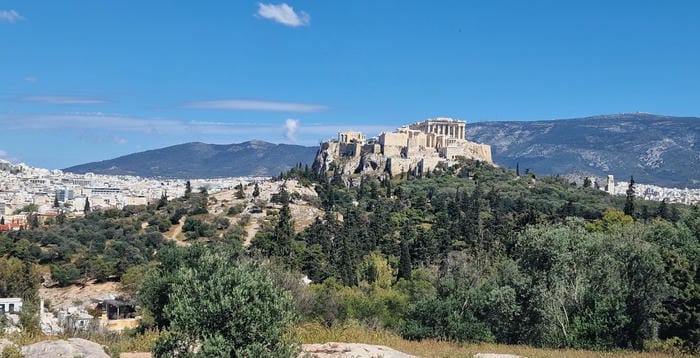
Philopappou Hill, also known as the Hill of the Muses, is another excellent spot for breathtaking views of Athens. Less crowded than Mount Lycabettus, it provides a serene escape where you can enjoy panoramic views of the Acropolis, the city’s modern sprawl, and even Piraeus port.
The hill is named after the monumental Philopappos Monument, erected in honor of a Roman senator. You’ll also find the remains of Socrates’ Prison, a site traditionally believed to have held the philosopher.
Philopappou Hill is ideal for a leisurely hike, with well-maintained paths winding through olive trees and wildflowers. As you ascend, you’ll find plenty of spots to pause and appreciate the vista or have a quiet picnic.
- Tips for Visiting: Visit in the early evening to enjoy cooler temperatures and watch the sunset. Bring water and a camera to capture the stunning views of Athens and the Acropolis.
10. Temple of Olympian Zeus
The Temple of Olympian Zeus is a marvel of ancient engineering and one of the largest temples ever built during Classical Antiquity. Though only a handful of its original 104 columns remain standing, these giant Corinthian columns—standing 17 meters tall—are enough to inspire awe.
Construction of this colossal temple began in the 6th century BC, but it wasn’t completed until centuries later by Emperor Hadrian in AD 131. The temple was dedicated to Zeus, the king of the Olympian gods, and it once contained a grand statue of the deity.
The site also includes Hadrian’s Arch, a monumental gateway that marked the boundary between the ancient city of Athens and the Roman city. This duality encapsulates Athens’ layered history and evolution as a cultural hub.
- Tips for Visiting: The temple site is included in the Acropolis combo ticket, making it easy to add to your itinerary. Visit in the morning for the best lighting for photographs and fewer crowds.
11. Panathenaic Stadium

The Panathenaic Stadium holds the distinction of being the world’s only stadium constructed entirely of marble. Originally built in the 4th century BC, it was redeveloped for the first modern Olympic Games held in 1896, making it an iconic landmark in sports history.
Known as the Kallimarmaro, meaning “beautifully marbled,” the stadium can accommodate up to 45,000 spectators and continues to be used for ceremonial events. Visitors can walk along the tracks, climb to the top tiers for sweeping views, or visit the small exhibition that showcases Olympic memorabilia.
The stadium is also historically tied to the ancient Panathenaic Games, similar to the Olympic Games, where athletes competed in honor of the goddess Athena.
- Tips for Visiting: Early morning visits offer the best experience, as the white marble can get quite dazzling under full sunlight. The small entrance fee is worth the opportunity to explore such an important historical site.
12. Hadrian’s Library
Constructed in AD 132 by Emperor Hadrian, Hadrian’s Library was once a vast complex built to house rolls of papyrus and serve as a cultural and intellectual center. Today, you can wander through its remains, which include columns, ruins of reading rooms, and storage areas.
Though much of the original structure has been lost, the ruins still evoke the grandeur of Roman Athens. Hadrian’s Library is conveniently located near Monastiraki Square, making it an easy addition to your day’s explorations.
- Tips for Visiting: Combine your visit with a tour of the Roman Agora, which is just steps away.
13. Syntagma Square & Changing of the Guard
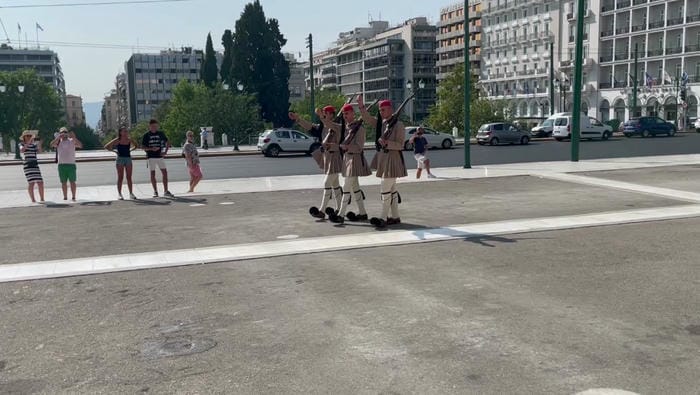
Syntagma Square sits at the heart of modern Athens and serves as a central meeting point for locals and tourists alike. The square is home to the Greek Parliament, where the Changing of the Guard ceremony takes place hourly.
The ceremonial guards, known as Evzones, stand watch in traditional uniforms, complete with pleated skirts and pom-pom shoes. The highlight is the elaborate guard change that occurs every Sunday at 11 a.m., featuring a full parade and marching band.
- Tips for Visiting: Arrive a few minutes before the hour to secure a good spot for photographs.
14. Ermou Street
Fashionistas and shopaholics should head to Ermou Street, a bustling pedestrianized street that stretches from Syntagma Square into Monastiraki. This commercial hub is lined with international brands, boutique stores, and local Greek designers, offering something for every taste.
Even if shopping isn’t on your agenda, a stroll down Ermou Street is a fun way to experience Athens’ modern vibe.
15. Kerameikos Cemetery
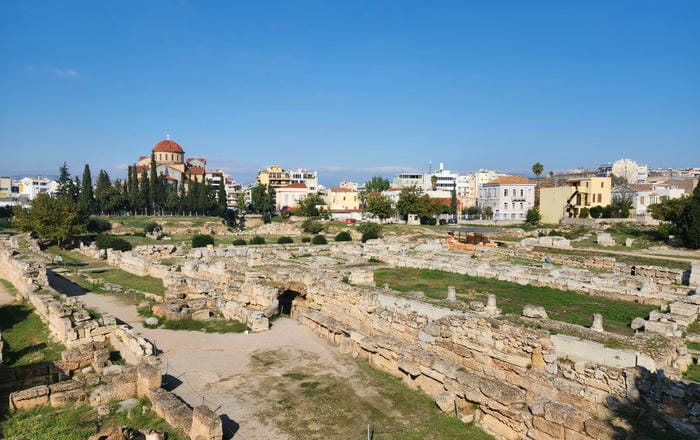
The Kerameikos Cemetery is the oldest cemetery in Athens and a significant archaeological site. It offers insights into ancient Athenian burial customs, featuring beautifully preserved tombstones, monuments, and a small museum showcasing funerary artifacts.
- Tips for Visiting: Visit in the morning for a peaceful exploration of this less-visited site.
16. Psiri Quarter
The Psiri Quarter is one of Athens’ trendiest and liveliest neighborhoods, making it a haven for culture and nightlife enthusiasts. Once a working-class district, Psiri has undergone significant rejuvenation and now attracts a diverse crowd with its creative vibe and bohemian personality.
During the day, you can explore its colorful street art, artisan workshops, and cozy cafes. At night, Psiri comes alive with its numerous bars, music venues, and traditional ouzeries, where you can sample ouzo (a famous Greek drink) alongside meze platters.
For those looking to experience authentic Athenian nightlife, Psiri’s open-air terraces and live music spots provide a memorable night out.
- Tips for Visiting: Visit in the evening to truly experience the neighborhood’s dynamic atmosphere. It’s especially lively on weekends, so consider making reservations at popular tavernas.
17. Metropolitan Cathedral of Athens
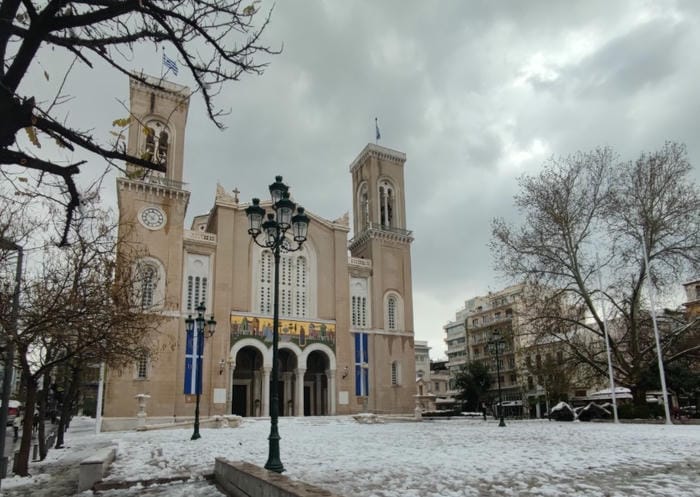
The Metropolitan Cathedral of Athens, also known as the Mitropoli, is the spiritual heart of Athens. Constructed in the mid-19th century, this neoclassical cathedral is a striking landmark in the city, especially with its richly decorated interior featuring intricate frescoes, marble detailing, and gilded accents.
The cathedral also houses the tombs of important Greek Orthodox saints, including Saint Philothei, a revered figure in Athenian history.
Adjacent to the cathedral, you’ll find the much smaller Church of St. Eleftherios, a charming Byzantine chapel built in the 12th century.
- Tips for Visiting: Pay attention to the church’s exterior carvings, which include ancient and medieval motifs. Respectful attire is recommended when visiting religious sites.
18. Panagia Kapnikarea Church
The Panagia Kapnikarea Church is one of Athens’ oldest churches, dating back to the 11th century, and is a fascinating example of Byzantine architecture. Situated along Ermou Street, this quaint, domed church stands in striking contrast to the modern surroundings of the bustling shopping avenue.
Its intricate frescoes and mosaics depict classic Christian iconography, while its history is steeped in legend. The church was reportedly built on a site where an ancient pagan temple once stood.
- Tips for Visiting: Stop by while exploring Ermou Street. Entry is free, so take a few minutes to step inside and admire the peaceful ambiance.
19. Museum of Cycladic Art

The Museum of Cycladic Art is a hidden gem for art and history lovers. Home to one of the most significant collections of Cycladic artifacts, this museum showcases ancient artworks and everyday items from the Cycladic civilization, which flourished in the Aegean during the Bronze Age.
The museum’s highlights include the iconic Cycladic figurines, minimalist marble sculptures that have inspired modern artists like Picasso. In addition to Cycladic pieces, the museum houses artifacts from other prehistoric Aegean cultures and classical antiquity.
- Tips for Visiting: The museum shop offers unique replicas and souvenirs inspired by Cycladic art, making it a great spot for gifts.
20. Areopagus Hill
Located just below the Acropolis, Areopagus Hill is a site of immense historical and mythological significance. This rocky outcrop was once the judicial and legislative center of ancient Athens. Later, it became famous for its association with St. Paul, who preached Christianity to the Athenians here in AD 51.
Climbing to the top rewards you with stunning views of the Acropolis, the Ancient Agora, and the city below. It’s a favorite spot for sunset lovers and photographers alike.
- Tips for Visiting: Wear sturdy shoes, as the rocks can be slippery. Arrive early for quieter moments or stay late to watch the sun dip below the horizon.
21. Varvakios Central Market

For a sensory feast, head to the Varvakios Central Market, Athens’ bustling food market. From fresh seafood and meats to vibrant fruits, vegetables, and spices, the market is a paradise for food lovers looking to connect with Athenian culinary culture.
The market also features small eateries where you can sample local delicacies like souvlaki, dolmades, and spanakopita (spinach pie). It’s the perfect spot to experience the raw energy of daily life in Athens.
- Tips for Visiting: Visit in the morning for the freshest produce and to see merchants in full swing. Make sure to bring cash, as some vendors may not accept credit cards.
Frequently Asked Questions
What is the best time to visit Athens?
The best time to visit Athens is during spring (March to May) and fall (September to November). During these seasons, the weather is mild, making it ideal for outdoor activities and sightseeing without the intense summer heat or winter chill. Additionally, these periods are less crowded compared to the peak summer months, ensuring a more relaxed experience. The city also comes alive during festivals such as Orthodox Easter in spring. While summer offers a vibrant atmosphere with numerous events, the scorching temperatures in July and August can limit daytime exploration.
How many days should I spend in Athens?
For a well-rounded experience, plan to spend at least three to four days in Athens. This timeframe allows you to explore the city’s historic sites, like the Acropolis and Ancient Agora, visit world-class museums, and immerse yourself in the local culture. Spend one day exploring central Athens’ archaeological landmarks, another day visiting museums and vibrant neighborhoods like Plaka and Monastiraki, and a third day hiking up Lycabettus or Philopappou Hill and discovering Psiri’s nightlife. Additional days give you the flexibility to take a day trip to nearby sites like Delphi or Sounion.
What are some free things to do in Athens?
Athens offers plenty of budget-friendly activities. Areopagus Hill and Philopappou Hill are free to visit and offer stunning views of the city. Stroll through the Plaka and Monastiraki neighborhoods to enjoy charming streets, vibrant street art, and lively squares. Churches like the Panagia Kapnikarea provide free entry, allowing you to admire their artistic and historical significance. Many museums and archaeological sites, including the Acropolis, offer free admission on specific dates throughout the year, such as the first Sunday of each winter month. Lastly, enjoy performances at Syntagma Square or simply relax at the National Garden.
Is it easy to get around Athens without a car?
Yes, getting around Athens without a car is convenient and straightforward. The city has an efficient public transportation system that includes buses, trams, and an impressive metro network with clean, modern stations. The metro connects key landmarks like the Acropolis, Syntagma Square, and Monastiraki. Walking is also a great way to explore the city center, as many attractions are within close proximity. For short trips, taxis and ride-sharing services are affordable alternatives. If you’re staying in the city center, you’ll find most locations readily accessible on foot or via public transit, minimizing the need for a car.
Conclusion
Athens is a city of contrasts, where the ancient and the modern coexist harmoniously, creating an unforgettable destination for all types of travelers. From its awe-inspiring landmarks like the Acropolis and the Temple of Olympian Zeus to its vibrant neighborhoods like Plaka and Monastiraki, Athens’ rich history and culture are evident at every turn. The city’s world-class museums, such as the Acropolis Museum and the National Archaeological Museum, reveal the fascinating legacy of classical Greece, while spots like Mount Lycabettus and Philopappou Hill offer breathtaking views of the sprawling metropolis.
Yet Athens’ charm goes beyond its historical sites. Its lively markets, bustling nightlife, and warm Mediterranean hospitality make it a captivating city where ancient traditions blend seamlessly with contemporary living. Whether you’re savoring authentic Greek cuisine, exploring hidden corners of Psiri, or simply watching life unfold in Syntagma Square, Athens promises a memorable experience.
As one of Europe’s most historic capitals, Athens is not just a destination—it’s a journey through time where every street and stone tells a story. Be prepared to discover a city that will leave you captivated long after your visit.
